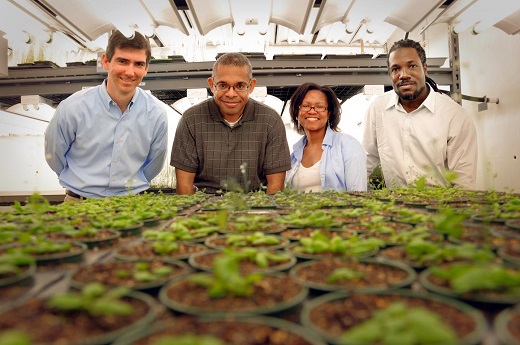Modeling tool IDs genes that control stress response in plants

An interdisciplinary team of researchers from North Carolina State University and University of California, Davis has developed a modeling algorithm that is able to identify genes associated with specific biological functions in plants. The modeling tool will help plant biologists target individual genes that control how plants respond to drought, high temperatures or other environmental stressors.
"The algorithm advances biological modeling techniques, providing further insight into which individual genes are involved in a given biological response, as well as which environmental factors influence that gene's behavior," says Cranos Williams, a corresponding author on a paper describing the work and associate professor of electrical and computer engineering at North Carolina State University.
"By narrowing the field from thousands of possible genes to less than 10, it will be much easier for biologists to understand how to develop drought-resistant crops or plants that can thrive in nutrient-poor environments," Williams says. "It's a key that could unlock a great deal of plant biology research with real world applications."
In order for a biological model to work, it needs data. In this case, the data comes from exposing a plant to stress.
The research team began with a bunch of model species Arabidopsis thaliana plants growing in normal conditions. Samples of the plants were taken to determine which genes were active, and how active they were. The plants were then exposed to environmental stress by being placed in iron-deficient media. Plant samples were taken at prescribed intervals for three days, to determine how gene activity changed at each point in time.
The researchers wanted to know how the plants responded to stress and which genes were responsible for triggering those responses.
But that posed a problem. There was a lot of gene activity going on. And it was hard to tell which genes related to which functions, or which genes served as the "transcription factors" that really got the ball rolling on a plant's response to stress. In fact, the researchers found activity in 2,700 different genes - far too many to test all of the possible options in the lab.
This is where the new modeling algorithm comes in. The researchers plugged all of the gene activity data into the algorithm, and the algorithm predicted that seven genes, or transcription factors, were involved in initiating the plant's iron deficiency stress response. That was a small enough number to test.
A transcription factor is like the first domino in a series. It makes one small signal, which then influences significant activity in "target" genes that are much more active in determining how a plant responds to stress. The researchers identified that the raw data - showing the activity of 2,700 genes - presented 931 possible transcription factor/target gene relationships. Again, too many to test.
But the algorithm narrowed it down to 32 predicted influential relationships between transcription factors and target genes. And, again, this was a small enough number to test.
When the algorithm's results were tested in the lab, researchers found that four of the seven predicted genes were relevant transcription factors. They also found that 17 of the 32 predicted influential relationships - 53 percent - were accurate. Of the four validated transcription factors, none had been previously linked to iron deprivation.
"We went from thousands of genes to seven, and from 931 possible relationships to 32 - making it possible to identify the relevant genes and interactions in weeks rather than decades," Williams says.
"What this algorithm does for plant biologists is significantly limit the number of interesting candidate genes to study, thereby decreasing the amount of time, energy, and funds it takes to identify important genes involved in stress response," says Terri Long, the other corresponding author on the paper and an assistant professor of plant and microbial biology at NC State.

 How to resolve AdBlock issue?
How to resolve AdBlock issue?